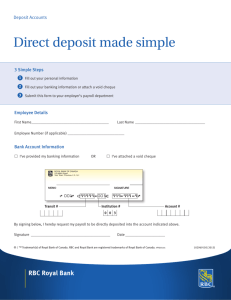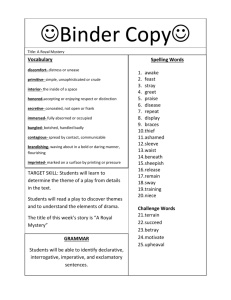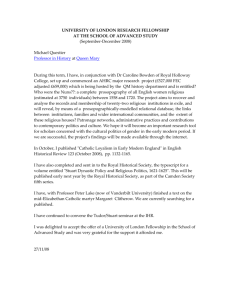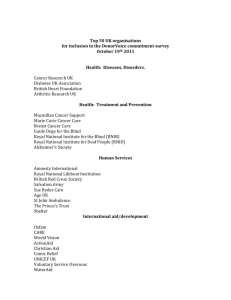Beyond Opening Day: Reinforcing Good Design at The Royal
advertisement
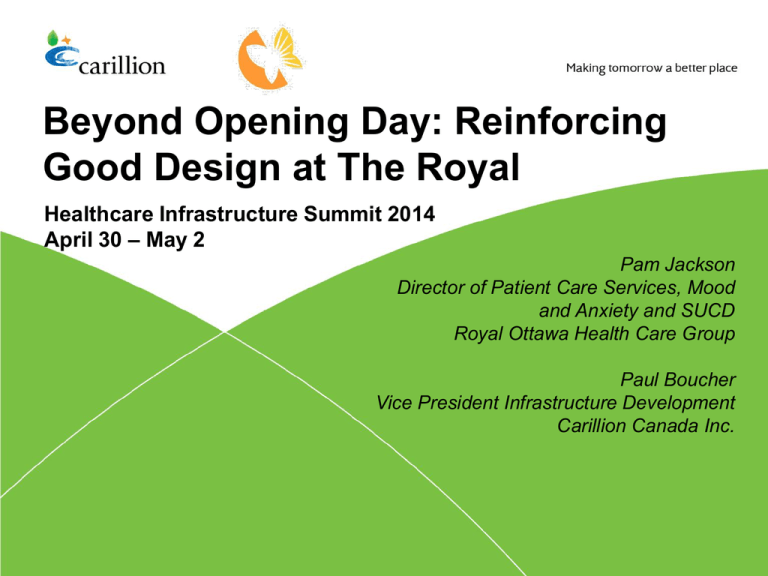
Beyond Opening Day: Reinforcing Good Design at The Royal Healthcare Infrastructure Summit 2014 April 30 – May 2 Pam Jackson Director of Patient Care Services, Mood and Anxiety and SUCD Royal Ottawa Health Care Group Paul Boucher Vice President Infrastructure Development Carillion Canada Inc. Beyond Opening Day... • Design is a “means to an end” – a virtuous circle of positive health outcomes by: ̶ Increasing patient comfort (mental and physical) ̶ Speeding healing ̶ Engaging family and community ̶ Promoting staff satisfaction and safety ̶ Delivering effective and efficient healthcare • Good design needs to be reinforced ̶ Preserve and maintain good design characteristics ̶ Adapt and change according to different needs, therapies, evidence, regulations ̶ Complement good design with good hard and soft facility management services • An excellent case study is provided by the Royal Ottawa Mental Health Centre (The Royal) 2 About The Royal Ottawa Health Care Group • One of Canada’s foremost mental health care and academic health science centres, delivering specialized mental health care, advocacy and research and education – to transform the lives of people with complex and treatment-resistant mental illness. • Vision: Mental health transformed through partnerships, innovation and discovery • Values: We are guided by innovation and a passionate commitment to collaboration, honesty, integrity and respect 3 Programs and Facilities at The Royal • Part of a continuum of care provided by The Royal for communities across Eastern Ontario: − Ottawa site (400,000 ft2): − 190-bed state-of-the-art Royal Ottawa Mental Health Centre − 96-bed Royal Ottawa Place for recovery and long-term care − Tower housing the Royal’s Institute of Mental Health Research − Brockville site: − 161 inpatient beds (61 forensic, 100 STU) − 183 beds in the community (Homes for Special Care) • Clinical programs at The Royal focus on: − Anxiety, mood and sleep disorders − Forensic, geriatric, youth and general psychiatry in transition − Schizophrenia; substance use and concurrent disorders • Serving 62,000 clients and families through in-patient and out-patient programs as well as outreach and education to the community, LTC facilities, shelters, etc. 4 Redevelopment at The Royal • In 2002, the Province on Ontario announced that a new mental health facility would be built to ... − Replace the century-old structures − “Bring mental health care out of the shadows” − Provide a leading-edge hospital... with a healing, therapeutic environment filled with natural light, extensive patient courtyards and a Winter Garden • An innovative Alternate Funding Plan (AFP) contract was signed in July 2004 and the new facility reached Substantial Completion in October 2006 • Canada’s longest running healthcare AFP project 5 Redevelopment at The Royal (cont’d.) • Under the AFP contract, the FM service provider delivers the following services to The Royal: − building, site, landscape maintenance − patient and retail food services − housekeeping and linen − waste management − security and parking − centralized Call Centre − lifecycle for the above • FM service provider is fully integrated into operations at The Royal, participating in all short and long-term planning and change management • Allows The Royal to maintain, adapt and improve building features from the original design to the present 6 Design Features and Positive Health Outcomes Summary of General Design-Outcome Relationships Even though redevelopment at The Royal preceded today’s organized Evidence Based Design approach, there were many features included in the design by John McSween at Parkin Architects for positive health outcomes 7 Opening Day Design Features at The Royal – Oct. 2006 • Emphasis on natural light for − all inpatient rooms − key therapy rooms − inpatient and Outpatient gathering spaces − naturally lit, 3-storey public space • Glass block was used extensively to provide “borrowed light” yet maintain privacy 8 Opening Day Design Features at The Royal – Oct. 2006 • Natural views and landscaping − secure courtyard access from rooms − greenhouse spaces − natural views for changes of season, wayfinding • Progressive spaces – bedroom, neighborhood, downtown − for longer term patients, organized as 4 residential areas with 16 patients each 9 Opening Day Design Features at The Royal – Oct. 2006 • Single Patient Rooms for >83% of mental health beds improve infection control, patient satisfaction, etc. • Separation of public and patient flows: − building core outwards, you move from public to semiprivate, outpatient areas to private inpatient areas − back-of-house corridors allow access treatment areas without going through public areas − secondary corridor surrounding the Winter Garden allows patients to bypass this public space − floor plan creates private “wandering loops” for patients • Flexible space configuration − “back-to-back” inpatient wards and door locations allow wards to grow and shrink according to demand − magnetic lock door locations allows forensic patients to visit gym without handcuffs, enhancing patient dignity • The Royal and its FM service provider have further adapted the facility to reflect operational realities…. 10 Adapting Design to Increase Clinical Effectiveness and Efficiency • Reworking space: − reconfigured reception and food retailing for better flow − created secure bicycle compound for staff − Constructed labyrinth after four years into operations • “As required” strategy for wall protection − FM service provider responsible for materials, portering − minimized wall protection for non-institutional look − reduced cost, increased visitor satisfaction • Expanded emergency power service: − more backed-up receptacles (e.g., CPAP machines) • Safety film for internal glazing without institutional look − shatter-resistant film applied for schizophrenic ward • Responding to regulations: − Converted to “non-smoking” shortly after opening − accessibility required additional washroom door openers 11 Adapting Design for Innovative Problem Solving Example #1 – Wheelchair room • Opening Day – plan was to clean wheelchairs off site but a separate “staging area” had not been programmed for soiled wheelchairs leading to infection control risks • At the same time, the sliding door to a group therapy area did not provide adequate privacy and noise attenuation • Solution? Re-purpose the sliding door to divide clean and soiled wheelchairs Example #2 – Dementia resistant door handle • Clinicians wanted to discourage dementia patients from leaving an area without having to restrain them • Solution? Facility General Manager Pedro Narbaitz developed a door handle shield that kept dementia patients in but did not impact functionality for staff and visitors 12 Reinforcing Good Design with Good Service • Supporting normalcy − food service provides choice for patients (including youth dietary preferences) − FM service provider personnel are frequently seen so distinctive uniforms avoided − control over environment (e.g. room temperature for patients in withdrawal) − precautions include maintenance work in pairs and taking tool inventory • Supporting transition − FM service provider participates in “graduation parties” − employment in food service has been explored 13 Summary and Lessons Learned • Redevelopment of The Royal introduced many state-of-the-art design features which have been associated with positive healthcare outcomes • Today’s healthcare facilities must adapt and evolve to cope with changes in therapies, patient needs, regulations, etc. − made possible through a highly collaborative relationship between hospital administrators and FM service provider − FM service provider should be fully integrated into hospital planning and operations with a wide scope of responsibilities − FM knowledge leveraged and shared with other healthcare facilities • Good design must be reinforced with “good service” to deliver the healthcare outcomes − services must complement design features − FM service provider personnel must recognize that they are part of the clinical environment and act accordingly 14 Thank You Questions?
